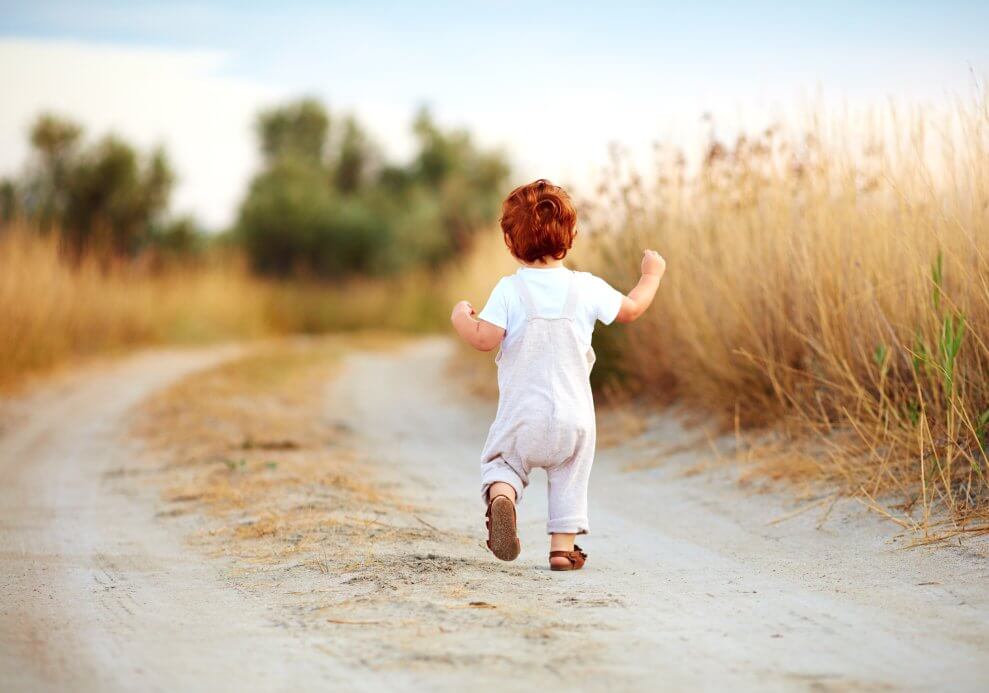
When should your toddler start running?
My toddler started walking at 13 months old. For a while, she’d push her little walker, getting as far as she could before plopping down on the ground. The day she really began walking was just as happy of a day for me as it was for her. Because the baby phase was difficult for me postpartum, I was ready for us to move onto the next phase. With her newfound independence though, it meant I’d have to keep a closer eye on her, while each day she gained more balance, confidence, and curiosity.
Luckily, I can still move faster than her.
But, at 19 months old, I noticed that she’s still not able to run quite yet. When we went to surprise her dad at the airport recently, she sort of waddled into his arms. Though it’s very clear she wants to run (and jump and swing and slide, etc.), we started to wonder more and more, When should she start running?
If you’re a parent also in this in-between phase with your toddler and asking yourself the same question, let’s find out the answer!
When will my toddler run?
Toddlers typically should be able to run by the time they’re 24 months old, according to the Canadian Paediatric Society. However, the exact age when they take those first little sprints can vary significantly from child to child. It’s important to remember that each child develops at their own pace. Some toddlers might start running earlier, while others might take a little longer to develop the coordination and confidence needed to run.
Crawl, walk, run…?
If your toddler has been walking—or engaging in any other of their gross motor skills—for quite some time, it can be a bit confusing as to why they haven’t been able to pick up running yet. One of the many old wives’ tales about children is that once they begin crawling, it’s only a matter of time before they begin walking. Surely the same logic would apply to walking and running, right?
Well, not quite. Our toddler crawled for a long time before she started running. I even had a friend whose daughter never “properly” crawled, but scooted on her butt to get around before she started to walk. (And some toddlers skip crawling altogether!)
The reality is there isn’t a strict ratio or fixed timeline between when a toddler starts crawling and walking—likewise between walking and when they begin running. After mastering walking, toddlers gradually gain more confidence, balance, and coordination, which eventually leads to running. Some children might prefer to walk for a while before feeling comfortable enough to try running, while others might enthusiastically start running shortly after they’ve gained their walking skills.
So, if your toddler is like ours (and like many toddlers!), first and foremost, don’t sweat it.

How can I encourage my child to start running?
Some parents may not be as enthusiastic about getting their toddler to run as they were about getting them to walk. After all, once they start running, you’ll have to be much more vigilant than you already are. All that said, though, running is an exciting milestone for toddlers, as there’s a whole new world of activities and discoveries that will open up to them.
So, if you’re wanting to sign them up for soccer already, we get it.
Though you should never push your child to do something before they’re physically ready to do so, you can encourage them to practice their running skills in a few ways:
- Create a safe environment for your toddler to explore and move around.
- Keep their path clear—it’s more difficult to run when there are toys, walls, or pedestrian traffic in the way.
- Make sure your toddler has sturdy shoes. Shoes that are too big, too small, or too uncomfortable can make it difficult to run.
- Take them to exciting places that capture their curiosity. A slide in the distance might spur them to run.
- Play games with them. Monkey in the Middle, tag, or hide and seek are great ways to encourage running.
According to the American Academy of Pediatrics’ Bright Futures guidelines [PDF], while all of these ways can be effective, the best way to encourage them to run is what’s known as unstructured play. When you promote the joy of moving early in life and throughout their childhood, they are more likely to grow up active.
“Simply playing outside—walking, running, climbing, and exploring the environment—is an important opportunity for physical activity. Structured play, which includes developmentally appropriate forms of physical activity, such as dancing or simple games, allows parents to help children master specific motor skills in a safe and supervised manner.”
-American Academy of Pediatrics’ Bright Futures guidelines
When to call your doctor
Again, if your child is under two and still not quite running yet, there’s likely no reason to worry. And, if you go to regular check-ups, your doctor will be able to keep tabs on their development. But if you’re concerned about your child’s development or have specific questions about their physical activity, it’s always a good idea to consult with a pediatrician or healthcare professional.
Generally, if your child hasn’t started running by age two, there may be another reason why. While there’s a wide range of normal development in toddlers, a delay in achieving certain milestones could sometimes signal an underlying issue that might need attention.
During the check-up, the healthcare provider can assess your child’s development, considering various factors like muscle tone, coordination, and any potential concerns that might be impacting their ability to run. They might recommend further evaluations or therapies if they suspect a developmental delay. Even if there’s a common orthopedic condition like bow-leggedness or toe-walking that might be the culprit, many times, children grow out of these or may need some physical therapy to do so.

What to keep in mind
When toddlers start running, the biggest concern can also pose new safety challenges. Here are some safety measures parents can take:
- Supervision: Keep a close eye on your running toddler, especially in new or potentially hazardous environments.
- Safe spaces: Create safe areas for running, such as fenced yards or playgrounds designed for toddlers. Ensure these areas are free from hazards like sharp objects or dangerous equipment.
- Appropriate footwear: Provide well-fitted, supportive shoes to protect their feet and aid stability.
- Teach safe practices: Encourage your toddler to watch where they’re going and avoid running near stairs, crowded areas, or places with potential dangers.
- Set boundaries: Establish boundaries for safe running areas and explain them to your child to help them understand where it’s safe to run.
- Supervise near roads: Be extra cautious near driveways, parking lots, or roads. Hold your child’s hand or keep them within a safe distance when walking near traffic.
- Childproof at home: Secure furniture and remove obstacles that could cause tripping or falling indoors.
- Education: Teach your child about safety rules, such as stopping when you call their name, being cautious around pets, and not running indoors.
- Stay attentive: Toddlers can be unpredictable, so always stay attentive even in familiar environments.
Going, going, gone…!
Alright, so it might take some time before our kiddo starts her track-and-field career, which will be a whole new adventure (for you as much as it will be for them!). But, before they’re really able to take off, take some time to enjoy them being able to just walk. After all, you’ll have to be even more vigilant once they start running.





